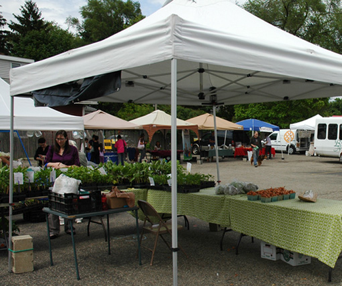
Many Michigan farmers markets, like the Allen Street Farmers Market in Lansing (pictured) are promoting their acceptance of food assistance benefits. Photo: Becky McKendry.
Food stamp use at farmers markets is expanding — and soon it may be easier for markets to accept food stamps.
The U.S. Department of Agriculture recently requested suggestions to improve service and eligibility requirements for Supplemental Nutrition Assistance Program benefits, also known as SNAP or food benefits. And the East Lansing-based Michigan Farmers Market Association (MIFMA) submitted comments calling for improvements in the way farmers markets seek SNAP eligibility.
Among the suggestions: Simplify the paperwork for markets to apply for SNAP eligibility and provide more assistance with associated costs.
“We have a lot of opportunities for growth here,” said Amanda Shreve, manager of programs and partnerships at MIFMA.
Markets across Michigan have started to accept food stamps, from the Allen Street Farmers Market in Lansing to the Downtown Marquette Farmers Market.
Shreve said there are approximately 300 farmers markets in Michigan, with about 130 accepting SNAP benefits as of May and with more applying all the time.
Although SNAP-friendly markets are growing in number, navigating the necessary paperwork and clerical work can be stressful.
That’s why the Park Township Farmers Market in Ottawa County doesn’t accept SNAP benefits, said Barb Burmeister, the market’s director.
“I would love to be able to offer it but the amount of work involved in the paperwork is prohibitive,” she said.
However, some larger individual vendors and farms that sell at the market are able to receive SNAP benefits, she said.
Burmeister said unless she finds money to pay for a point-of-sale device and hire someone to process paperwork, she doesn’t foresee accepting SNAP benefits.
“If we had a bigger staff or more money, we would love to do this like the Holland Farmers Market downtown,” she said. “Unfortunately, smaller markets don’t have as many resources and it would be a burden.”
Jean Kohler of the Cadillac Area Farmers Market recalls similar stress when her market applied for the program.
“I remember we had to submit an application and wait for approval,” she said. “Then something was wrong with the paperwork and we had to apply again. It was back and forth, back and forth.”
Kohler said although the market applied last year, it was unable to accept SNAP benefits until this year because it was initially sent a transaction machine that requires electricity — which the Cadillac Market doesn’t have.
She also said the market struggled with figuring out how many tokens — used as market currency — to buy and whether they could be reused.
The good news, Kohler said, is that now that everything is up and running, it’s a success.
“People have really been thrilled for this program,” she said. She said one day this year, 44 customers used their food benefits.
“We’re a small market,” she said. “That’s a ton for this area.”
MIFMA does provide technical and financial assistance and advice to markets, but the easier it is for markets to apply, the easier it is for MIFMA as well, its program manager said.
“We would appreciate support for these efforts because we also have limited staff and limited money,” Shreve said.
MIFMA aims to have 50 percent of all Michigan farmers markets accepting SNAP benefits by 2015 and at least one SNAP-friendly market in 75 percent of Michigan counties.
Shreve said she feels “absolutely” confident about meeting that goal, but that there’s always more work to do.
“We have a lot to celebrate in Michigan in the amount of SNAP redemption we’ve accomplished, but we also have a way to go,” she said.